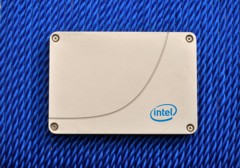
Intel Corporation ha annunciato la nuova linea di unitÓ di storage di tipo solid-state drive (SSD), orientata al mercato consumer, denominata Intel SSD 520. La proposta commerciale di Intel include cinque drive con interfaccia SATA III, o SATA 6Gbps, realizzati con l'ausilio di chip di memoria NAND a 25nm.
In accordo al produttore, gli SSD 520 utilizzano un processore SandForce e rendono disponibili prestazioni finora mai
raggiunte da SSD consumer-oriented. Pi¨ in dettaglio, i nuovi drive a stato solido supportano fino a un massimo di 80.000
Input-Output Operations Per Second (IOPS) (in modalitÓ di scrittura random di blocchi da 4K) e fino a un massimo di 50.000
IOPS in lettura random da 4K. In lettura e in scrittura sequenziale gli SSD 520 fanno registrare dei valori di data rate pari
rispettivamente a 550MB/s e 520MB/s.
I nuovi SSD, che supportano la cifratura Advanced Encryption Standard (AES) a 256-bit, sono disponibili in cinque differenti
capacitÓ, ovvero 60GB, 120GB, 180GB, 240GB e 480GB, ed hanno un MSRP (inteso come prezzo unitario in stock da 1000 pezzi)
pari rispettivamente a $149, $229, $369, $509 e $999.

[Immagine ad alta risoluzione]

Intel Corporation announced today its fastest, most robust client/consumer solid-state drive (SSD) to date, the Intel
Solid-State Drive 520 Series (Intel SSD 520), a 6 gigabit-per-second (gbps) SATA III SSD produced using Intel compute-quality
25-nanometer (nm) NAND memory process technology. Aimed at delivering world-class performance for even the most demanding PC
enthusiasts, gamers, professionals or small-medium businesses (SMBs), the Intel SSD 520 has fast throughput performance, new
security features and unmatched reliability to meet even the most intensive user requirements.
Any consumer application requiring high throughput and bandwidth, low latencies and accelerated speed will benefit from the
Intel SSD 520. Software developers, architects, accountants, engineers, musicians, media creators and artists are just some
of the professionals that will find that the Intel SSD 520's full package of features can make a dramatic impact on their
productivity. With faster performance for graphic renderings, compiling, data transfers and system boot-ups, users can speed
through multi-tasking or once-cumbersome application wait times with an Intel SSD 520 Series.
"We tapped Intel engineering to create a client SSD that delivers performance on all fronts with obsessively high
reliability," said Rob Crooke, Intel vice president and general manager of the Intel Non-Volatile Memory Solutions Group.
"The Intel SSD 520 once again raises the industry bar on SSD performance, quality and reliability to dramatically improve
user experience."
Unlike a traditional hard disk drive (HDD) with spinning disks and moveable parts, an SSD is based on silicon, NAND flash
memory specifically, to create a lower power, more reliable and drastically faster storage solution that can keep up with
today's most demanding applications, Internet streaming and intense multi-tasking. Based on its own industry-leading 25nm
Intel compute-quality NAND flash memory and a 6gbps SATA III interface, the Intel SSD 520 uses an LSI SandForce Flash Storage
Processor with an Intel co-defined and validated firmware release, to create an SSD that sets new industry performance
benchmarks. The Intel SSD 520 delivers up to 80,000 maximum 4K random write Input-Output Operations Per Second (IOPS) and up
to 50,000 4K random read IOPS to speed through every day operations. High sequential read performance of up to 550
megabytes-per-second (MB/s) and up to 520MB/s sequential writes also markedly accelerate and improve user productivity. This
is backed by thousands of hours of Intel testing and validation, including more than 5,000 individual tests, as well as a
5-year limited warranty.
"We worked closely with Intel to leverage their deep understanding of the NAND flash, ultimately providing a unique and
optimized solution for client computing applications with the LSI SandForce Flash Storage Processor," said Michael Raam, vice
president and general manager of LSI's Flash Components Division, formed by LSI's acquisition of SandForce. "Working through
Intel's extensive validation process ensures the Intel 520 SSD will raise the bar in delivering top-tier performance and
superior quality and reliability over the life of the drive."
The Intel SSD 520 will mark the high end of its client SSD offerings and include these new features: a wide range of user
capacities from 60GB to 480GB, Advanced Encryption Standard (AES) 256 bit encryption capabilities and stronger password
protection for added security in the event of theft or power loss. According to PCMark Vantage benchmarking, users of the
Intel SSD 520 may see significant productivity gains through an up to 78 percent boost in overall PC responsiveness, and
gamers will see an up to 88 percent jump in performance to enhance their gaming experience.** IT professionals will not
onlyprovide this additional performance and productivity to their customers/employees, but find that the Intel SSD 520 also
delivers on reliability, improved security, smoother operations and lower total operational costs.
"Our game development workflow involves a combination of large batch process and aggressive interactive pre-visualization,
all highly parallelized to the point that the storage performance becomes a major bottleneck," said John Carmack, founder and
technical director of id* Software, a gaming software developer and creators of Doom and Quake. "For many of our workloads,
Intel SSDs have doubled throughput, and in some cases involving mapping tens of gigabytes of image data, we have seen an
honest order of magnitude performance improvement, which is a rare and wonderful thing."
With a broad range of capacity choices, the Intel SSD 520 Series is priced as follows, based on 1,000-unit quantities: 60GB
for $149, 120GB at $229, 180GB at $369, 240GB at $509 and 480GB at $999. It comes with a 5-year limited warranty. To download
the multimedia press kit go to http://www.intel.com/newsroom/ssd. For more information on Intel SSDs go to
www.intel.com/go/ssd or follow Intel SSDs on Twitter (@intelssd), Facebook (www.intel.com/go/ssdfacebook or
communities.intel.com).
News Source: Intel Press Release
Links

